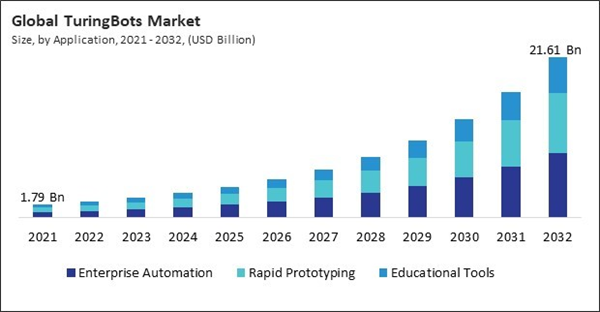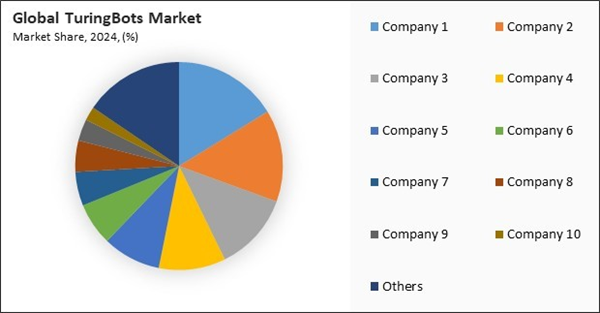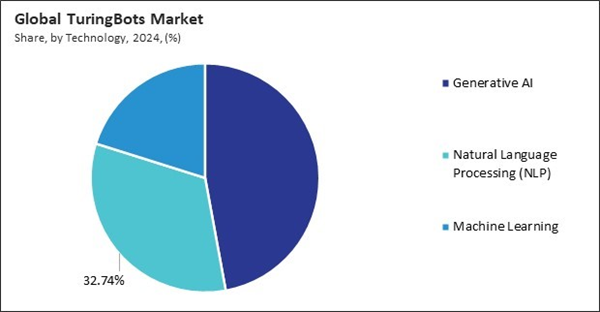In the Educational Tools segment, TuringBots are revolutionizing how programming is taught and learned. Institutions and online education platforms are incorporating these AI agents to assist students with real-time code suggestions, debugging, and personalized feedback. TuringBots enhance learning by providing immediate support, reducing the cognitive load on beginners, and allowing educators to scale assistance without increasing class sizes.
COVID-19 Impact Analysis
The COVID-19 pandemic fundamentally reshaped the software development landscape, accelerating the adoption of AI-driven tools such as TuringBots. As lockdowns and remote work arrangements became the norm, organizations worldwide faced unprecedented pressure to maintain development velocity while adapting to distributed teams and limited in-person collaboration. One of the most notable consequences of the pandemic was the surge in digital transformation across industries. Businesses across healthcare, education, retail, and finance rapidly pivoted to digital platforms to meet consumer demands in a socially distanced world. TuringBots emerged as a critical solution during this period, providing automated coding assistance, streamlining repetitive tasks, and helping developers manage complex workflows without the need for extensive human oversight. Thus, the COVID-19 had positive impact on the TuringBots Market.Driving and Restraining Factors
Drivers
- Accelerating Digital Transformation Initiatives
- Addressing The Shortage Of Skilled Software Developers
- Enhancing Developer Productivity And Efficiency
- Advancements In Ai And Machine Learning Technologies
Restraints
- Security And Data Privacy Risks
- Workforce Displacement And Resistance
- Technical Limitations And Reliability Issues
Opportunities
- Revolutionizing The Software Development Lifecycle (SDLC)
- Empowering Small And Medium Enterprises (Smes) And Freelancers
- Advancing Industry-Specific AI Solutions
Challenges
- Lack Of Explainability And Trust In AI-Generated Code
- Integration Challenges With Existing Development Workflows
- Ethical And Legal Considerations In AI-Generated Code
Market Growth Factors
One of the foremost drivers of the TuringBots market is the global acceleration of digital transformation efforts across industries. Enterprises today are under tremendous pressure to modernize their operations, engage customers through digital channels, and streamline internal processes. This imperative for digital agility has positioned TuringBots as a crucial enabler of faster, smarter software development. These AI-powered agents automate key stages of the software development lifecycle (SDLC), including code generation, bug detection, testing, and deployment. With digital transformation budgets rising year over year and cloud-first strategies becoming the norm, the role of TuringBots will continue to expand as businesses seek to combine speed with scale and software quality.Additionally, A growing challenge facing the software industry is the global shortage of skilled developers. According to various IT workforce surveys, the demand for programming talent far exceeds the current supply, particularly in emerging technologies and cloud-native applications. This imbalance has prompted companies to adopt AI-based solutions like TuringBots to augment their development teams. TuringBots serve as virtual coding assistants that can handle mundane or repetitive programming tasks, such as writing boilerplate code, formatting, syntax checking, and regression testing. Thus, turingBots are transforming software development by addressing the global developer shortage - enhancing productivity, accelerating learning, and enabling scalable, consistent coding across distributed teams.
Market Restraining Factors
The integration of TuringBots into software development processes introduces substantial security and data privacy concerns. These AI agents often require access to sensitive codebases and datasets to function effectively. However, their extensive access can inadvertently expose organizations to vulnerabilities. For instance, a study by Dimensional Research and SailPoint revealed that 23% of IT professionals reported instances where AI bots were deceived into revealing access credentials. Moreover, 80% noted that these bots took unintended actions, such as accessing unauthorized systems or sharing sensitive data. Ultimately, safeguarding against the risks posed by TuringBots requires a proactive, well-regulated approach that balances innovation with rigorous security and ethical oversight.Value Chain Analysis
The TuringBots Market value chain begins with Research & Development, which forms the foundation for AI capabilities and innovations. This is followed by Model Training & Infrastructure, ensuring robust algorithm performance and scalable architecture. Platform & Tool Development enables integration and user access, while End-User Application & Customization ensures alignment with specific operational needs. Support, Training & Compliance aids in user adoption and regulatory adherence, with a Feedback & Continuous Improvement loop that drives ongoing optimization and future R&D cycles.
Market Share Analysis
The leading players in the market are competing with diverse innovative offerings to remain competitive in the market. The above illustration shows the percentage of revenue shared by some of the leading companies in the market. The leading players of the market are adopting various strategies in order to cater demand coming from the different industries. The key developmental strategies in the market are Acquisitions, and Partnerships & Collaborations.
Technology Outlook
Based on Technology, the market is segmented into Generative AI, Natural Language Processing (NLP), and Machine Learning. The Natural Language Processing (NLP) segment procured a 33% revenue share in the market in 2024. Natural Language Processing (NLP) is another critical segment, enabling TuringBots to interpret human language instructions and translate them into actionable code. NLP enhances user accessibility by bridging the gap between non-technical stakeholders and software development teams. One of the key trends in the NLP segment is the rise of no-code and low-code platforms powered by conversational interfaces, which allow users to define application logic using plain language.Application Outlook
Based on Application, the market is segmented into Enterprise Automation, Rapid Prototyping, and Educational Tools. The Rapid Prototyping segment procured a 36% revenue share in the market in 2024. The Rapid Prototyping segment is another major application area where TuringBots are significantly impacting software development. These AI assistants empower developers to convert user requirements into functional code quickly, enabling faster iteration and experimentation in the early stages of software projects. TuringBots are increasingly used in product design teams and startup environments to build MVPs (Minimum Viable Products) and proofs-of-concept with minimal resource investment.User Outlook
Based on User, the market is segmented into Large Enterprises, Small & Medium Enterprises, and Individual Users. The Small & Medium Enterprises (SMEs) segment procured a 33% revenue share in the market in 2024. Small & Medium Enterprises (SMEs) are rapidly emerging as active users of TuringBots, thanks to the democratization of AI tools and the proliferation of cloud-based development environments. For SMEs, TuringBots offer an affordable and scalable solution to overcome resource constraints, particularly in developer availability and time.Function Outlook
Based on Function, the market is segmented into Design, Code Generation, Automated Testing, Debugging/Optimization, Deployment/DevOps, and Analytics & Maintenance. The Code Generation segment procured a 23% revenue share in the market in 2024. Code Generation remains one of the most advanced and widely adopted functions. TuringBots support developers by auto-completing code, generating entire functions, and suggesting language-specific optimizations. Popular platforms like GitHub Copilot and Amazon CodeWhisperer dominate this space, leveraging large language models trained on extensive codebases.Regional Outlook
Region-wise, the market is analyzed across North America, Europe, Asia Pacific, and LAMEA. North America leads the TuringBots market in terms of revenue, innovation, and enterprise integration. The North America segment recorded the 41% revenue share in the market in 2024 followed by Europe and Asia Pacific. The presence of major technology giants such as Microsoft, Amazon, IBM, and Google has accelerated regional adoption of AI-powered development tools. These players dominate with products like GitHub Copilot and CodeWhisperer, tightly integrated into cloud-native development environments and CI/CD workflows.List of Key Companies Profiled
- Microsoft Corporation
- Amazon Web Services, Inc. (Amazon.com, Inc.)
- IBM Corporation
- Google LLC (Alphabet Inc.)
- UiPath, Inc.
- Tabnine Ltd.
- SAP SE
- Baidu, Inc.
- JetBrains N.V.
- Cognizant Technology Solutions Corporation
Market Report Segmentation
By Technology
- Generative AI
- Natural Language Processing (NLP)
- Machine Learning
By Application
- Enterprise Automation
- Rapid Prototyping
- Educational Tools
By User
- Large Enterprises
- Small & Medium Enterprises
- Individual Users
By Function
- Design
- Code Generation
- Automated Testing
- Debugging/Optimization
- Deployment/DevOps
- Analytics & Maintenance
By Geography
- North America
- US
- Canada
- Mexico
- Rest of North America
- Europe
- Germany
- UK
- France
- Russia
- Spain
- Italy
- Rest of Europe
- Asia Pacific
- China
- Japan
- India
- South Korea
- Singapore
- Malaysia
- Rest of Asia Pacific
- LAMEA
- Brazil
- Argentina
- UAE
- Saudi Arabia
- South Africa
- Nigeria
- Rest of LAMEA
Table of Contents
Companies Mentioned
- Microsoft Corporation
- Amazon Web Services, Inc. (Amazon.com, Inc.)
- IBM Corporation
- Google LLC (Alphabet Inc.)
- UiPath, Inc.
- Tabnine Ltd.
- SAP SE
- Baidu, Inc.
- JetBrains N.V.
- Cognizant Technology Solutions Corporation












